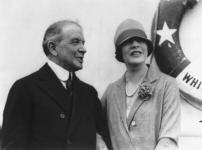William Crapo Durant (1861–1947) automobile executive and investor
Born in Flint, Michigan, in 1861, Durant left high school before graduating to become a traveling cigar salesman. After other jobs selling, he purchased a carriage manufacturer after being impressed with the smooth ride of its carriages, which were supported by coil spring suspension. At age 25, Durant and a partner, Josiah Dallas Dort, purchased the Coldwater Road Cart Co., a manufacturer of carriages, with $1,500 borrowed from a bank. Within several years, the company was the nation’s largest of its type, producing more than 150,000 units per year, and was the largest employer in Flint.
After making his first million manufacturing carriages and wagons, he entered the automobile business in 1904 when he became chief executive and treasurer of the Buick Motor Company at the behest of James Whiting, the company’s president. Buick soon acquired the Cadillac Motor Company, and the two companies produced highly regarded touring cars. Within several years, Durant proposed that the four leading auto manufacturers of the time combine to form a giant company to be called the International Motor Car Co. But two of the four, Ford and REO, demurred, and Durant founded GENERAL MOTORS (GM) instead. In 1908, GM was incorporated and sold stock initially worth $12 million. Within two years, it acquired Oldsmobile and Pontiac. But after an internal dispute, Durant lost control of the company in 1910 to a bankers’ group, which provided financing. He remained as a vice president of GM.

Before World War I, Durant opened several new companies, including the Chevrolet Motor Co. and the Republic Motor Co. He regained control of GM after acquiring a majority of its stock in the market but lost it again in 1920, after falling out with the company’s primary bankers at J. P. Morgan. In 1921, he founded Durant Motors and became a major speculator in the stock market. His investment activities overshadowed his car company, and he became heavily leveraged by borrowing money on margin to buy stocks. He became known as one of the most celebrated investors in the stock market prior to 1929. He tried to convince President Herbert Hoover about the dangers of a crash prior to October 1929, blaming the FEDERAL RESERVE for the market’s problems. When the 1929 crash occurred, he lost most of his fortune.
Later in his life, Durant left the auto industry and investing and operated several bowling alleys near his home in Flint, Michigan. He never again had the capital for successful business ventures. He died in obscurity in 1947. His major legacy remains the initial organization of General Motors, which overtook Ford as the major auto producer in the United States in the mid-1920s.
See also AUTOMOTIVE INDUSTRY.
Further reading
- Madsen, Axel. The Deal Maker: How William C. Durant Made General Motors. New York: John Wiley, 1999.
- Seltzer, Lawrence H. A Financial History of the American Automobile Industry. Boston: Houghton Mifflin, 1928.
- Weisberger, Bernard A. The Dream Maker: William C. Durant, Founder of General Motors. Boston: Little, Brown, 1979.